While most folks think of evergreen species like pine bonsai and boxwood bonsai as the attractive plants year-round, crabapple bonsai are actually one of the most aesthetically pleasing species year-round. They’re also fairly easy to care, style in almost any bonsai shape desired, and make for fascinating bonsai subjects. They’re a great choice for beginners and intermediate bonsai growers, as long as you’ve got a little time to care for them properly.
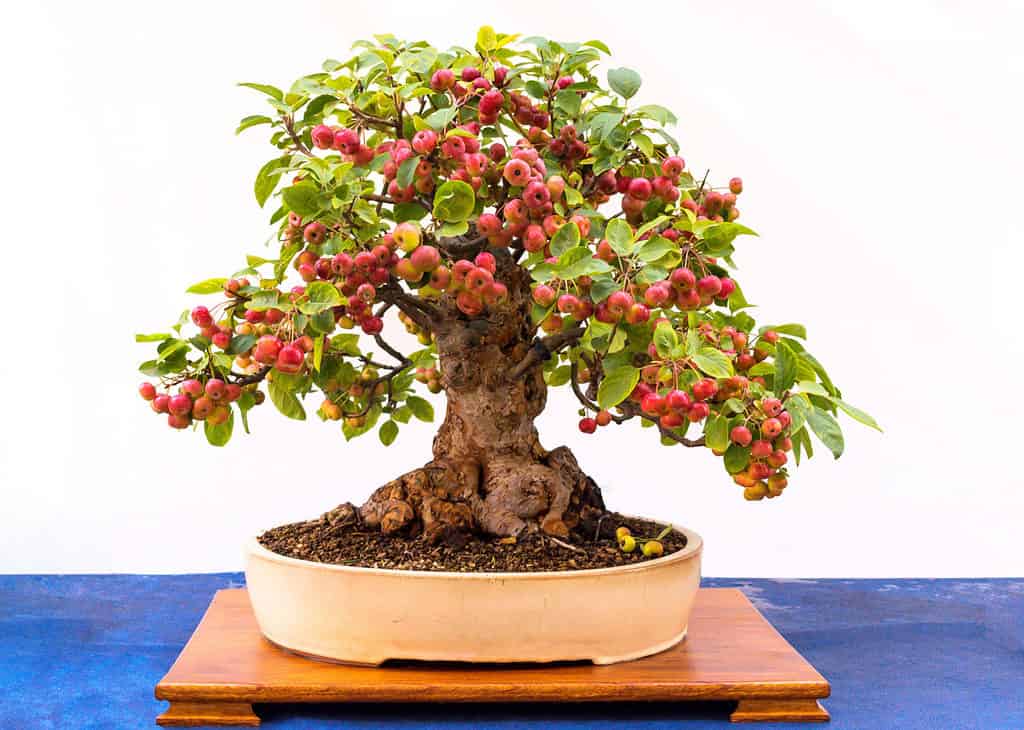
Crabapple bonsai are are a fairly easy species to grow.
©Sergio Arjona/Shutterstock.com
What Makes Crabapple Good for Bonsai?
Crabapples make for wonderful bonsai for a number of reasons, including the fact that they are fairly easy to care, do best when kept outdoors in bright sunlight in cool to temperate climates, produce attractive fruit that stays on the trees through winter, and produces vibrant flowers and leaves the rest of the year.
Crabapple Classification
Crabapples are members of the same family as apples, the Malus genus, within the Rosaceae family (yes, roses). The genus contains an estimated 30 to 55 species of small deciduous trees and shrubs. Among these are crabapples, apples, rainberies, and wild apples.
Crabapple Bonsai Description
Crabapples have many descriptions, which in some cases may make them difficult for specifically identify. A general description, however, involves colorful fruit ranging from yellow to red, flowers that range from pink to white to red or purple, and leaves of various shapes and forms. Most of the fruit is cherry-sized or smaller, and the fruits turn even more vibrant in color when left on trees during the cold months of winter. The flowers may be single, double or semi-double form, as well, with typically yellow stamens. They typically bloom light one year and profusely the next.
Origins and History of Crabapple Trees
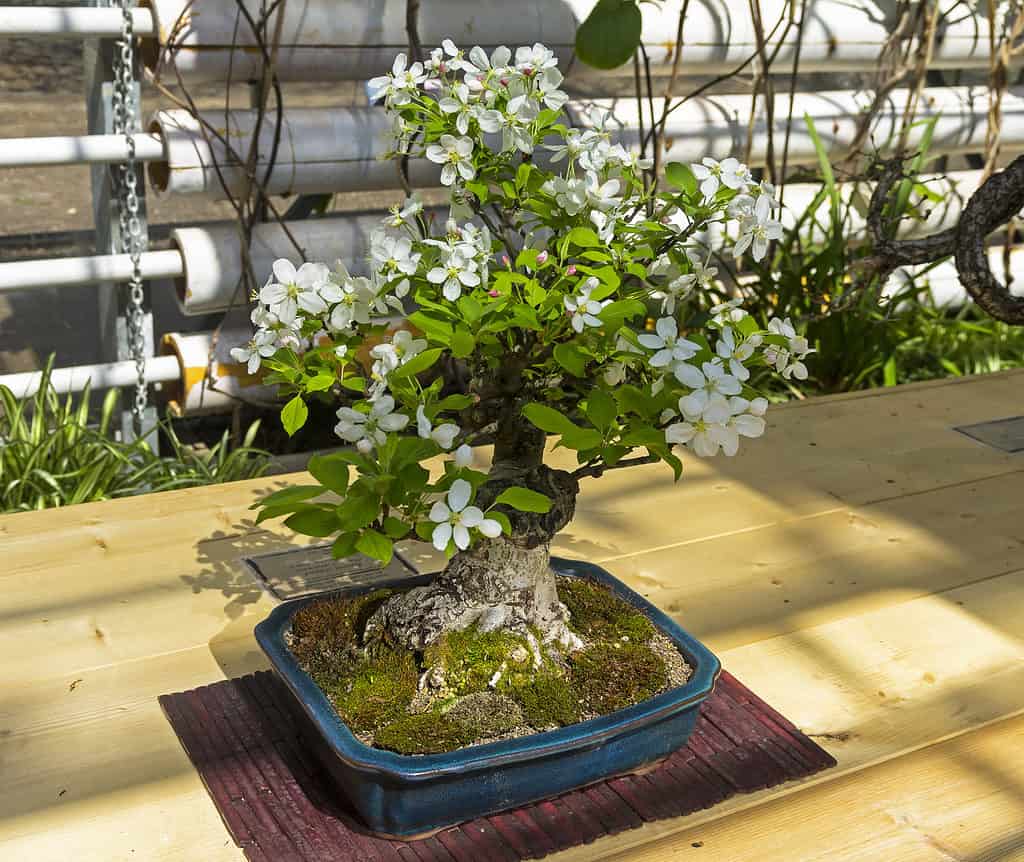
Crabapple bonsai in full bloom
©Sergey Rybin/Shutterstock.com
Crabapple trees are native to cold climates like Asia and Russia. Records indicate the trees came to North America in the 1700s, brought over due to the ornamental nature of the attractive plants year-round. These ornamental good-looks are largely what attracts bonsai enthusiasts to the trees.
Varieties of Crabapple Trees
There are a large number of crabapple species that have been used to create bonsai trees.
- Malus halliana – known as Hall’s crabapple, with deciduous leaves that are narrow, dark green, and glossy. They bloom with pink flowers and produce purple fruit. This species works as a bonsai but rarely produces fruit in this format.
- Malus sieboldii – known as Siebold’s crabapple or the Toringo crabapple, with small pink buds that grow into white flowers, with yellow or red fruit
- Malus baccata – known as the Siberian crabapple, with egg-shaped leaves, red fruit, and white flowers
- Malus ‘Golden hornet’ – known as the golden hornet crabapple, with yellow fruit and white flowers
- Malus ‘Red jade’ – known as the weeping crabapple, with bright green leaves, pink and white flowers, and red fruit
- Malus cerasifera – known as the Nagasaki crabapple, with pink buds that turn into white flowers, with cherry red fruit
- Malus sylvestris – known as the common crabapple, with oval, toother leaves, white flowers tinged with pink, and red and yellow-green fruit
- Malus ‘Profusion’ – known as the purple crabapple, with purple leaves, red fruit, and red flowers
- Malus x micromalus – known as Kaido crabapple or Makino crabapple, with dark pink buds that turn to light pink or white flowers, red or yellow fruit
- Malus floribunda – known as Japanese flowering crabapple, with pink buds that turn into white flowers, toothed medium green leaves, and yellow or red fruit
How to Grow Crabapple Bonsai

Crabapples, like orchard apples, may come in a wide range of colors and variations.
©Igor Sirbu/Shutterstock.com
In the wild, crabapple trees are exceptionally hardy trees. However, as bonsai, they have restrictions put on them, due to their size and the limitations of the size of pots in which they grow. Because of this, it’s important to keep certain care conditions in mind.
Planting Location
Crabapple bonsai are sun lovers, so they have a few specific location requirements to keep in mind as you tend them.
First, they need full, direct sun but may dry out unless kept watered well. If you are unable to water the tree midday when soil goes dry, ensure the tree will have shade at the hottest times of the day. They also do not thrive in cold weather as bonsai. They must be kept in temperatures above hard frosts. However, they do not do well as a year-round indoor plant. They should be kept outdoors in temperatures between 20 and 80-degrees F and brought indoors outside those parameters.
When kept indoors in extremely hot or colder weather, ensure they are not near drafts, air vents, air conditioners, heaters, or doors leading to the outdoors. These may hinder the health of your crabapple bonsai. They also need to be kept cooler than 80-degrees or the tree may have stress and be affected long-term.
Lighting
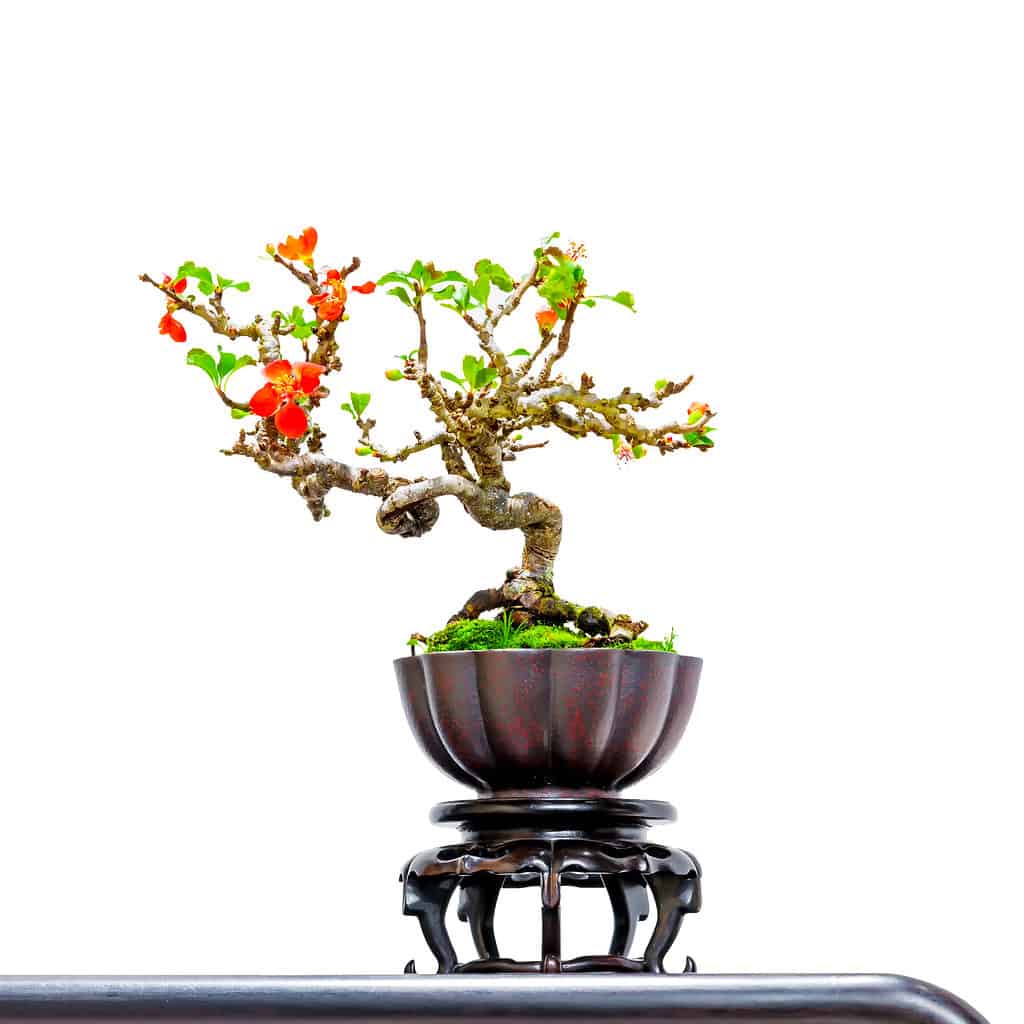
Some crabapple trees produce vivid red blooms.
©QQQQQQQT/Shutterstock.com
Crabapple bonsai thrive in bright, full sunlight. This means they may dry out if not properly cared for, though, so ensure they are in partial shade if you’re not able to move the pot during the day and water midday when it gets hottest.
Temperature
Your crabapple bonsai will thrive in temperatures between 20- and 80-degrees F. If your area gets colder than this, you will need to bring your bonsai indoors and protect it from frost.
Humidity
When you bring your bonsai indoors, experts recommend putting your bonsai into a shallow tray that is filled with gravel and water. This will help to boost the humidity surrounding the plant in the cooler months. In warmer weather, you’ll want to spray the foliage gently with moisture, particularly in the hottest times of day.
Watering

They may be trained in almost any bonsai style.
©QQQQQQQT/Shutterstock.com
Like most plants, your crabapple has different watering needs, depending on the season. In the dormant, winter seasons, the crabapple should have the soil kept evenly moist but never overly wet. During the growing season, the tree should be watered daily, particularly on hot days when the sun tends to dry them out.
Use distilled, purified, or rainwater for the bonsai to keep it healthiest, avoiding straight tap water if at all possible. During the hottest months, spray the foliage with water, as well, to help encourage the plant to thrive. Additionally:
- Never let the soil get completely dry. If this is happening in the heat of summer, move the bonsai into partial shade.
- The size of the pot will potentially impact how frequently your bonsai needs watering. If you find in cooler seasons it still needs watering near daily, consider repotting into a smaller pot.
- Use a moisture meter to avoid over or under watering.
- Apply water to the soil until it starts to run out of the drainage holes.
- If using a sprayer of any kind, ensure that the spray nozzle is set to the gentlest setting.
Feeding
There are a few different things you should consider for feeding of your crabapple bonsai. You may use bonsai specific or general fertilizers at half strength. Liquid fertilizers are best, though other types will work.
- Balanced fertilizers should be applied in the springtime or summer after flowering and fruiting has completed, but with a gap after flowering to ensure you don’t stunt the fruiting.
- Low nitrogen fertilizers should be used in later summer.
- Apply zero nitrogen feed in the autumn.
- Do not feed during fruiting of the crabapple.
- Resume fertilization only after fruit has fully developed.
- Reduce feedings to every other month once winter hits.
Pruning, Pinching, Shaping, and Wiring
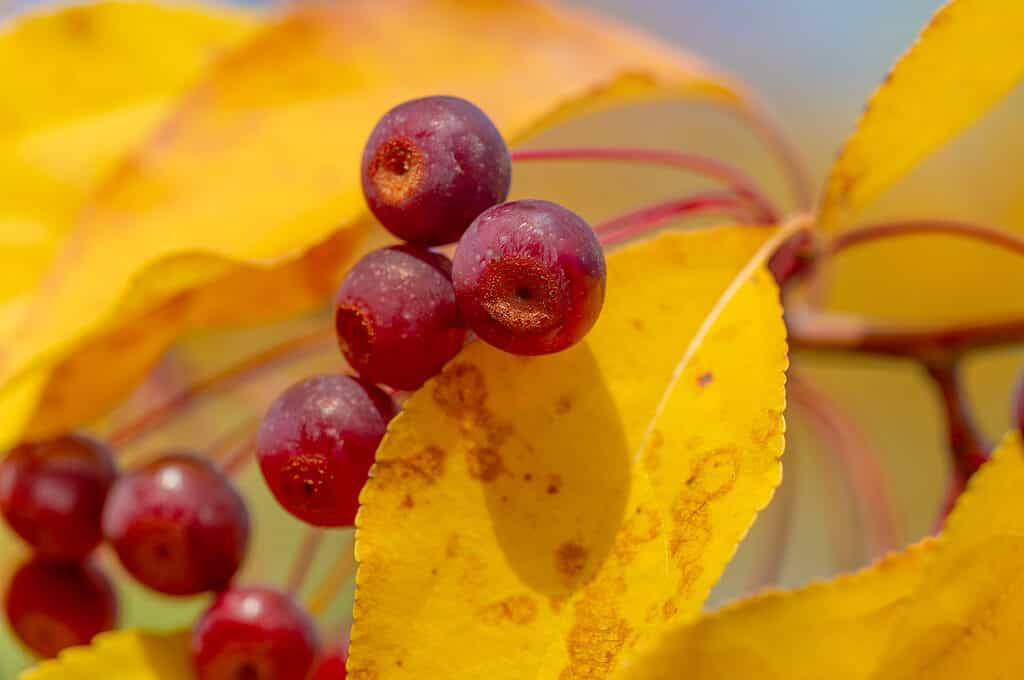
Malas baccata have vivid red fruits and bright yellow leaves in autumn.
©Sergei Mishchenko/Shutterstock.com
Autumn is the best season for pruning established branches and long shoots. New shoots, however, should be pruned in mid to late summer after flowering has ended. Prune back to two or three leaves or nodes and pinch any new shoots to one or two leaves after flowering. Let the tree grow without interruption at this stage, save for wiring, which should either occur in spring or autumn.
Crabapple bonsai are typically styled as informal bonsai in single or multiple trunk styles. You may guy wires or raffia for the wiring of the trees, but be sure that any wiring is only done with gentle metals like aluminum, not copper. However, only a few styles don’t particularly work for crabapple, including driftwood, forest, windswept, and literati. Pretty much any other style may be employed for your crabapple bonsai.
Re-potting
Crabapple bonsai should be repotted every 2 years in early spring, when the tree is coming out of dormancy but hasn’t started budding yet. The crabapple bonsai requires a deeper bonsai pot than many varieties, so ensure the plant has the space it needs to conserve moisture and insulate its roots within the pot.
When you re-pot, use bonsai soil mix or a multipurpose compost potting mix. Always ensure the pot has proper drainage holes and easy drainage through use of pebbles or gravel in the potting mix. Some folks even use a fine mesh to help keep the nutrients in the soil while allowing the pot to drain more thoroughly between waterings.
Some folks recommend using a soil mixture of 30% grit and 70% organic matter, or a clay-based loam with sharp sand in equal parts.
When you re-pot, rake the old soil out from the roots. There’s some debate on how much of the root mass to trim, with some folks suggesting as little as 25% and more experience bonsai enthusiasts recommending up to 75% of the root mass. About 50% is probably the safer portion for folks less familiar with the bonsai art.
Once the roots are trimmed, place the screen in the pot, add in a layer of gravel or pebbles, thin fill in with a layer of soil. Next, add in the roots and fill in around the roots with the potting mix. Water the crabapple immediately after re-potting and avoid feeding for about 4 weeks.
Common Problems of Crabapple Bonsai

The tree is attractive year-round.
©LutsenkoLarissa/Shutterstock.com
There are two common issues with crabapple bonsai: mildew and aphids.
Aphids
If you notice tiny spots under the leaves or the leaves start to look discolored or “weak”, check for aphids. These are tiny little insects that drain the “life blood” from plants and are usually situated on the underside of leaves.
To get rid of them, manually remove them with your hands, wearing gloves. Then, gently apply a nontoxic pesticide at about half the strength of the packaging recommendations. If the aphids recur, repeat the treatment. Make sure you don’t apply the treatment while the soil is wet.
Mildew or Mold
Mildew and mold may occur, as well, usually due to the wrong climate conditions or overwatering. Check the root ball and soil for water logging.
First, check the location of the crabapple. Often, mildew and mold occur because the plant isn’t getting enough air movement or there is too much water in the soil. Move the plant to an open air space where it is protected from rainfall. If the root ball is waterlogged, you may need to re-pot the plant with fresh potting medium.
Next, apply a gentle, nontoxic fungicide to the plant as directed. Make sure you don’t apply the treatment while the soil is wet. Once the fungicide has done its work, gently clean the branches, leaves, fruit, and trunk with rubbing alcohol and let dry. Water and feed as normal.
Apple Canker, Rust, and Other Conditions
In the case of other issues like rust or canker, use a gentle fungicide as directed above. In the case of other insects, apply the pesticide at half strength and treat as directed on packaging otherwise.
How to Propagate Crabapple Bonsai

Full-sized crabapple trees can tolerate colder temperatures and heavier snow than crabapple bonsai may.
©LutsenkoLarissa/Shutterstock.com
There are two primary ways that folks propagate crabapple bonsai. The first is through seeds, the second through cuttings. Air layering may also be done in late spring or early summer. For either air layering or seeds, use standard methods to grow the crabapple bonsai tree.
The more preferable propagation, because it tends to be easier and faster, is growing from rooted cuttings. To do so:
- Get cuttings from semi-hardwood on a healthy crabapple tree.
- Take the 6-inch cuttings in summertime, removing most of the leaves (around three-quarters).
- Use a talc-based hormone powder and dip the cut ends into it.
- Place the cuttings in a clean flat with 4 parts perlite, 1 part peat.
- Cover the tray loosely with plastic and moisten.
- Keep the cuttings moist as they work at rooting, which should take about 4 weeks to occur.
- Once the cuttings have rooted, plant them in bonsai growing medium in their intended pots.
- Water immediately and maintain the soil at the proper moisture level.
- Care for as directed above.
Crabapple Bonsai FAQs
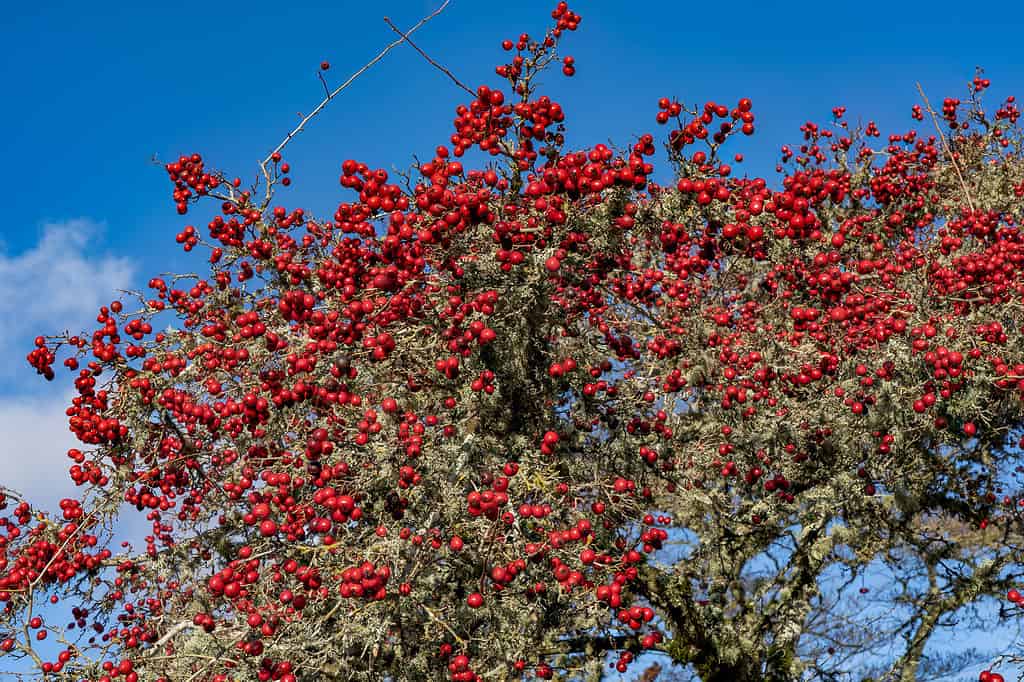
A full-size crabapple tree is quite the impressive sight.
©Bob Pool/Shutterstock.com
There are a couple of common questions folks ask about crabapple bonsai. Hopefully these FAQs will help answer your questions.
Can you grow crabapple bonsai indoors?
Unfortunately, no. Crabapple bonsai do not survive indoors. They should be kept outdoors for prime health. There may be some exceptions in which you can give the tree precisely its needs indoors, but most folks aren’t able to do that and so it’s recommended to keep them outdoors.
What should I look for in a crabapple bonsai?
It’s best to avoid purchasing a crabapple bonsai while it is blooming. It’s better to buy the tree during summer when the tree is in full foliage. It’s easier to evaluate the health of the tree at this time. When you’re looking, also ensure that the tree has a strong trunk and many small forks in the branches.
Up Next:
- Jade Bonsai Tree
- The 11 Best Indoor Bonsai Trees
- The 10 Best Outdoor Bonsai Trees
- The 10 Best Bonsai Trees for Beginners
The photo featured at the top of this post is © Sergio Arjona/Shutterstock.com
Thank you for reading! Have some feedback for us? Contact the AZ Animals editorial team.







